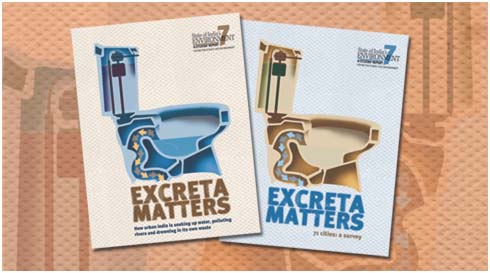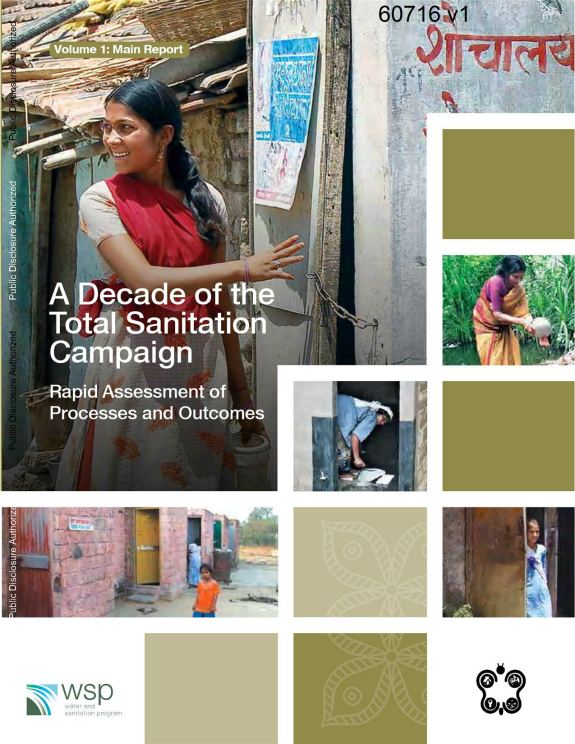Toilets and Urinals
Handbook on technical options for onsite sanitation by the Ministry of Drinking Water and Sanitation
Posted on 22 Nov, 2014 10:30 AMThis handbook by the Ministry of Drinking Water and Sanitation provides sustainable technological options for on-site sanitation for different hydro-geological conditions. The hand book is divided into six chapters and a bibliography.
Excreta Matters A profile of the water and sewage situation in 71 Indian cities A report by the Centre for Science and Environment
Posted on 22 Nov, 2014 10:30 AMGuset post: Amita Bhaduri

Source: Excreta Matters, Centre for Science and Environment, 2012
The sanitation crisis in India An urgent need to look beyond toilet provision
Posted on 22 Nov, 2014 10:30 AMGuest post by: Aarti Kelkar-Khambete
Image Courtesy: Wikimedia Commons
The sanitation crisis and the recent evidence on lack of toilet facilities
Government of Rajasthan prepares a working draft of a rural sanitation and hygiene strategy 2012 2022
Posted on 22 Nov, 2014 10:30 AMAlthough significant progress has been made in terms of individual household toilet coverage in the state, usage by the population is still low at 12.9 per cent (DLHS 2007-08). Access to toilets for schools and angawandies has seen a marked increased but rural solid and liquid waste management has seen little or no attention.
Community managed sanitation in Kerala Tools to promote governance and improve health A Report by the World Bank Institute
Posted on 22 Nov, 2014 10:30 AMIt also deals with the efforts made by the Government of India to revolutionise sanitation services in the state of Kerala, with the aim of improving public health. Earlier experience had shown that significant governance problems had hindered water and sanitation reforms in local and national programmes in the state.
First international advocacy planning meeting for water and sanitation activists WASH News and policy update
Posted on 22 Nov, 2014 10:30 AMContent courtesy: India WASH Forum
Confessions of an OD boy- The need to achieve a sustainable open defacation free intervention
Posted on 22 Nov, 2014 10:30 AMAuthor: Mohanasundar Radhakrishnan
Hue and cry for drinking water Major struggle for natures call A study by Udayvani and Arghyam
Posted on 22 Nov, 2014 10:30 AMThis study by Udayvani and Arghyam describes the findings of case studies undertaken by Udaywani to get a clear picture of the drinking water and toilet facilities in 8 Gram Panchayats of the 6 Districts of Karnataka following the ASHWAS survey conducted by Arghyam that included a survey of Household Water and Sanitation in 172 Gram Panchayats across 28 districts of Karnataka (all except Bangalore Urban).
A decade of the Total Sanitation Campaign : Rapid assessment of processes and outcomes A report by the World Bank
Posted on 22 Nov, 2014 10:30 AM This report by the Water and Sanitation Program (WSP), The World Bank analyses primary and secondary data from the Total Sanitation Campaign (TSC) of the Government of India, which has been in operation for over a decade (1999 to date).
This report by the Water and Sanitation Program (WSP), The World Bank analyses primary and secondary data from the Total Sanitation Campaign (TSC) of the Government of India, which has been in operation for over a decade (1999 to date).
The audience for this report includes policy-makers and implementers at national, state and district levels, and the broader sanitation and hygiene community. The report aims at gaining an understanding of the processes, outputs and outcomes of the campaign at a national level and across the states as compared with the inputs that have gone into the program.
The report draws on these indicators, which are then compared individually and in combination to benchmark the states, to understand the relative performance of the states. This benchmarking, based on a combination of eight indicators, is undertaken for both states and districts across the country.
Equity and inclusion in sanitation and hygiene in South Asia A regional synthesis paper WSSCC UNICEF and WaterAid
Posted on 22 Nov, 2014 10:30 AMThis working paper by the Water Supply and Sanitation Collaborative Council (WSSCC), UNICEF and WaterAid highlights the fact that a staggering 716 million men, women and children defecate in the open every day, in South Asia, contributing to the most appalling concentration of poverty and disease and the poorest standards of hygiene in the world.





